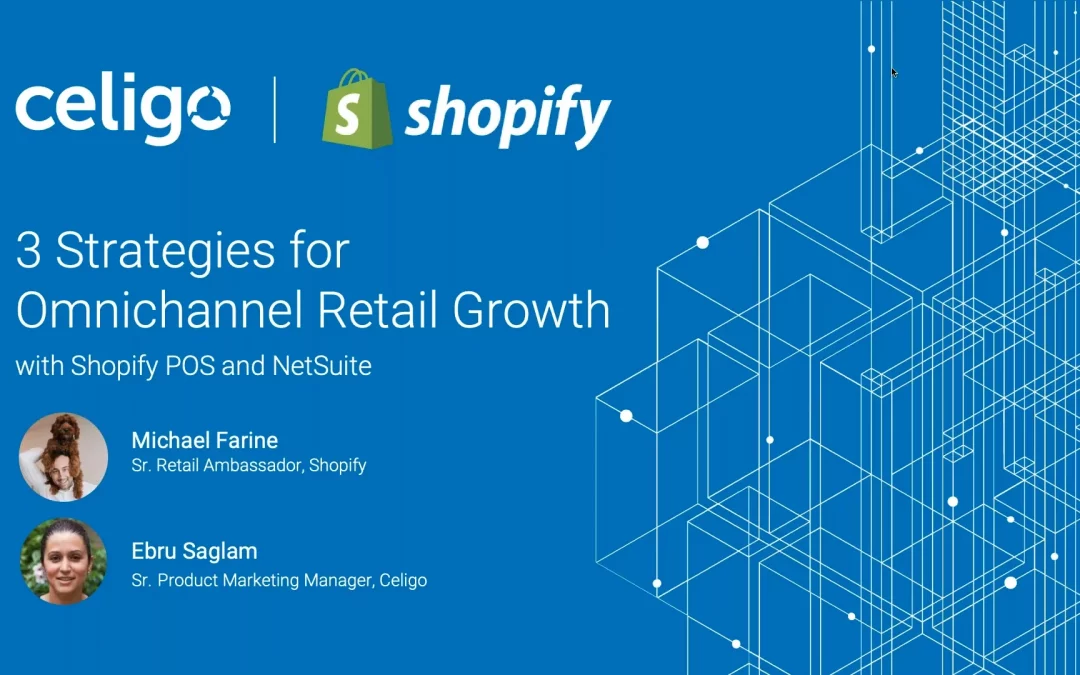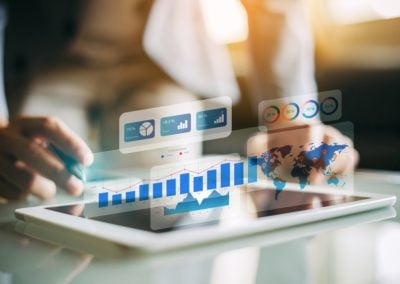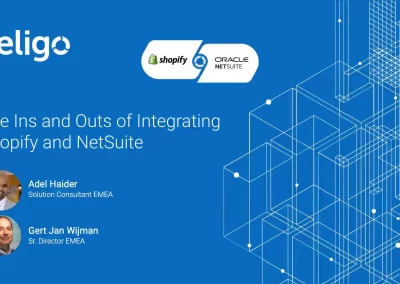On Demand Webinar
3 Strategies for Omnichannel Retail Growth with Shopify POS and NetSuite
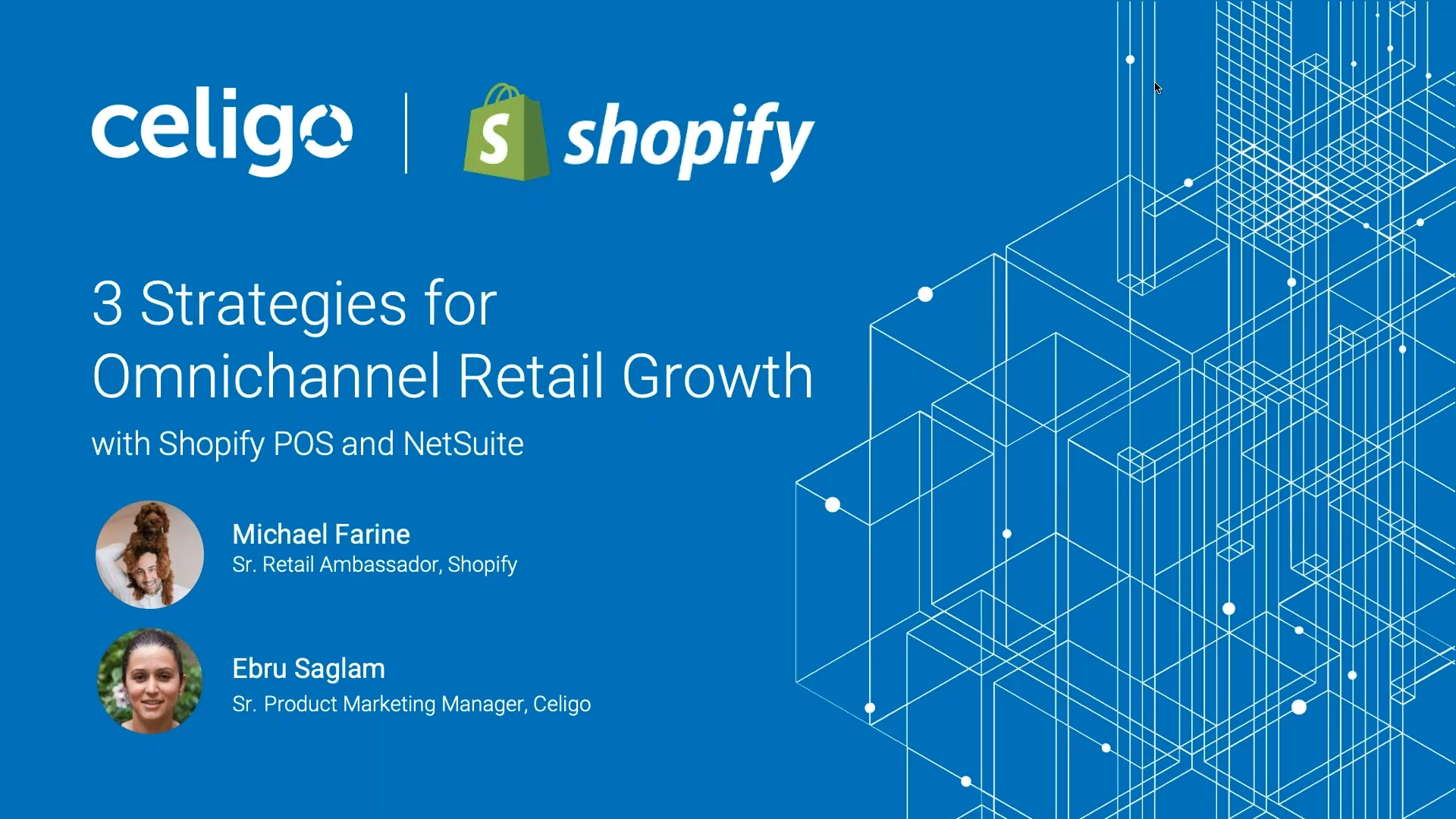
Do you have the right strategies in place to grow your business? Are you delivering a seamless omnichannel experience to your customers? Providing convenient and safe shopping options to consumers during the COVID era drives sales and improves customer experience. In order to scale with growth, businesses also need to plan for processing of large order volumes through different channels on the operational end.
Retail and ecommerce experts from Shopify and Celigo discuss strategies to deliver a seamless omnichannel sales experience across Shopify’s POS systems, online storefronts and NetSuite ERP.
You will learn about:
- How COVID has impacted retail
- Strategies for omnichannel retail growth in this new era
- How to unify DTC retail and ecommerce sales for a seamless customer experience
- How to automate omnichannel operations to scale with growth
- Q&A
Full Webinar Transcript
Hello, everyone. Thank you for joining us today. My name is Ebru, and I work in product marketing at Celigo. And I’m excited to have a guest speaker from Shopify with me today. So, our speaker is Michael Farine. He’s a senior retail ambassador at Shopify. And Michael helps merchants become omnichannel, and he has worked with merchants like Molson Coors, Egg New York, and Herve Leger in adopting omnichannel strategies. And today, he will talk about a very hot topic. So first, he will talk briefly about how COVID has impacted retail. And then, he will talk about how leveraging omnichannel strategies for retail growth can help navigate the challenging landscape in this new era. And I will talk later about the role of integration and executing those omnichannel strategies. So, I hope that you’ll find this session useful. And at the end, if we have time left, Michael has some bonus content for some actionable retail insights. So, we would like to share these. And if it happens that we run out of time, you will receive the contact by email. And if you have any questions during the presentation, you can submit them through the questions pane in your control panel. And we’ll be answering them at the end of the webinar. So, before I hand it over to Michael, I just would like to give some quick information on Celigo in case you’re not familiar with us. So, Celigo is an iPaaS integration platform as a service company. And we are the largest NetSuite partner. So, today, we have more than 3,000 shared customers. And our customers, they are everywhere across the globe. And we serve many leading retail and manufacturing businesses. So, you can see some examples here. And we are also a Shopify plus partner. And we have an out-of-the-box Shopify NetSuite integration app that helps Shopify merchants integrate their online storefront and retail point of sale systems with NetSuite. And we’ve been in the Gartner Magic Quadrant for the past couple of years. And then, other than Shopify, some other examples of our popular integrations that we see our customers use are 3PL and also integrations for applications such as Amazon, Walmart, eBay, Zendesk, or Returnly are among the popular ones. And so, if you’re not familiar with the iPaaS platform, so iPaaS is actually short for integration platform as a service. And on an iPaaS, you can basically connect any application that has a level of connectivity to any other application and automate your business processes. For example, you can connect your ERP system, such as NetSuite to your warehouse management system and automatically fulfill and track inventory across different warehouse locations. And here you can see some of the other applications that can be connected on Celigo’s iPaaS, and now I will hand it off to Michael. Thanks so much, Ebru]. Happy to be here, everyone. Thanks for joining. I’m just going do the similar Shopify at a glance. I actually had Ebru edit the e-commerce platform note to be a commerce platform because that’s really what Shopify is. We are a platform for our merchants to sell and reach their customers anywhere. We have over 1.5 million merchants on the platform, and our mission is to make commerce better for anyone, for everyone, whether that’s with best in class tools solutions omnichannel capabilities as well as best in class support. We’re here to make it better for everyone. We also have 100 partners in the Shopify network, including Celigo, and we’re happy to be involved in this webinar. So we’re going to start off with the state of retail and emerging challenges that come with these COVID impacted times. So I would argue that retail has been one of the most affected industries by COVID in the entire world. Everyone experienced earlier this year that retail just completely closed down. From there, merchants were able to find their customers and make sales through turning their retail environments to fulfillment hubs. What that means is local delivery by online pickup in store, curbside pickup, all of those actions were able to reach their local customers through omnichannel approaches. But moving forward, I got this from Doug Stevens on the Business of Fashion website that I predict retail’s going to turn into an experience hub. Whether that’s appointment-based selling, whether it’s pop-ups, showrooms, a fulfillment hub is no longer sustainable. So how do we change our retail environments to become an experience hub? Other challenges, of course, for retailers, other than COVID is all about reaching new customers. Having the infrastructure to reach your customers locally through those fulfillment hub experiences is one way to do it. But going past and beyond that, how do you reach these new customers in this digital age? Another challenge is these brick and mortar merchants that I talk to, they have a very loyal customer base that comes into their store. How do we reach them if our retail stores are closed with COVID? So retaining those customers and reaching them through other channels is one of the challenges here. And, of course, competition, whether it’s Amazon, marketplaces, social channels, there’s so much demand for ad space, customer eyeballs. There’s so many like products out there that the competition is so fierce. So how do retailers stand out from the crowd? Another challenge that I hear time and time again is that a lot of merchants that I deal with are brick and mortar first. That means they’ve built their business in retail stores, and with COVID impacting their stores, they have no digital presence. So how did they go online? How did they have the capacity that technical know-how to go online and continue business as usual? This one is especially relevant with larger merchants that would potentially be using that NetSuite and Celigo fragmented customer experience. These legacy enterprise merchants use one platform for online, one platform for in-store, and what suffers in this setup is the customer experience. Their information, order history, returns or exchanges, loyalty gift card, the list goes on. Those things are siloed in between two different channels. So having that fragmented customer experience is a challenge that we at Shopify hear every single day. Lastly, one of the last challenges they have here is the inventory visibility. Again, fragmented experiences result in lack of visibility across your storefronts, the warehouse, or online. This is where Celigo and NetSuite actually play a really, really awesome hand to Shopify merchants. They manage the inventory operations, receiving transfers, workflows, fulfillments. In that way, the Shopify customer experience is a great add-on to the NetSuite and Celigo back end to make sure that inventory is visible and accurate in real-time. So those are some challenges. So what are some strategies and how to become Omnichannel and reach the growth that you guys are looking to do? So I want to start off with this study from the Harvard Business Review. They surveyed 46,000 shoppers to gauge what impact Omnichannel retailing had on their experience. From this survey, they found that 7% shopped online exclusively. That means that they didn’t go into a store. 20% store-only shoppers. That means they didn’t shop online. And I’m not sure if this is a surprise, it shouldn’t be but 73% use multiple channels to purchase their item. That really speaks to the Omnichannel platform, Omnichannel growth. If you think you are reaching all your customers that you have in your database you might be mistaken because there are so many different channels out there and your customers are smart as ever doing the research and the recommendations to find the products they want and then purchasing through various means. So why take an Omnichannel approach? Omnichannel is the platform. But what is the function? What is the result of becoming Omnichannel? The first is flexibility to buy. Your customers have various preferences. Some you may know, some you may not. Perhaps they’re in town and I want to pick up– maybe they’re more inclined to buy something off Instagram. You don’t know the exact preferences of your customers but with an Omnichannel platform, you don’t need to know. Having all of your products available across all different channels, accurate inventory, seamless experience for your customers will allow them the flexibility to buy, and see more sales with your brand. Top right, we have customer experience. From my understanding, from my experience, Omnichannel is all about customer experience. This is exactly what Omnichannel is trying to do. Those fragmented experiences as I was mentioning earlier through something like Shopify which is an Omnichannel Platform out of the box. Again, returns or exchanges, customer profiles, knowing exactly who they are, what they purchased and why will strap you and your marketing teams to see growth, know exactly what their preferences are, and then really kind of play into those strengths there. Next, we have simplify the back office. I’d like everyone who’s listening on the call to think about the day to day operations of their business. How much manual work. How much reconciliation has to be done between various platforms whether it’s inventory, it’s customer information, it’s order fulfillment, marketing, accounting. The list goes on. How much of that is a manual process due to the technology stack that you guys have currently? Fragmented experiences result in that as well. And moving over to Shopify, for example, you can simplify all of that through one platform because everything’s on the same database, same platform allowing you to put the time back into your brand and less time reconciling on a day to day basis. Building brand loyalty goes back to customer experience. I think, everyone, if you were to put yourself in the shoes of a shopper. I know you guys have all bought things in the past. A seamless customer experience whether it’s returns or exchanges, the actual loyalty points, email marketing, coupons. All this stuff plays a big hand into what brand you kind of go back to for more and more. And through Omnichannel, loyalty is number one. Reducing marketing efforts. This goes back to reconciling customer databases. So a lot of the merchants that I chat to, that are larger and have these big enterprise solutions fragmented experiences. They have two customer databases which provide a very cumbersome reconciliation at the end of the day. Whether they want to do marketing towards their retail-only clients, or they want to do marketing towards their online-only clients, this is a very big time suck. So having all of your customer database to be on one omnichannel platform will reduce those efforts, have more visibility, and allow you to see growth. And then lastly, why take an only-channel approach is to diversify your audiences. If you just think about Amazon, Instagram, Facebook, and online stores in general, you can know that the demographic for each are completely different. Maybe younger generations, younger demographics will be on Instagram, while the older bunch will be on Facebook or online. So having all of your products available on all of these different channels will see audiences that you are going after and diversify exactly who you’re reaching. Okay. So now, let’s get down to the strategies. I’d like everybody to take a second and think about the last thing that they purchased. Maybe it was an office chair for their at-home office, maybe it was a computer stand, maybe it was a Peloton like me, whatever the case may be, I want you to think about the journey you took to making the decision for why you bought that specific item. For example, maybe you did some– maybe you’re scrolling on Instagram. You got served an ad. You went to the company’s website. Did a bit of research. Read some reviews and recommendations. Watched a YouTube video. And then went over to the online store to check out. Potentially, you saw that there’s a showroom in your local area. You went to the showroom. Interacted with the brand. Had a one-to-one shopping customer experience because you’ve already interacted with them online. And then you checked out. This seamless experience is exactly what your customers expect to have in this day and age. And like I mentioned earlier, they’re smarter as ever. They’re going to do the recommended– they’re going to do the research. They’re going to do the review research to make sure that what they’re buying is sound. And having a seamless experience across all of those channels is vital. And that goes back to the brand loyalty as well. So customers who have a seamless experience are more likely to go back to that same brand. And having it all in one platform is exactly how you do that. Don’t let in-store stockouts turn into lost sales. So this plays very well into Celigo and NetSuite as well. I want everyone to think about their business again as well. And if they have– how many times has a customer asked for a specific item, but it wasn’t in stock in your store? And you didn’t know where it was amongst your other stores or warehouse. Maybe you have to call somebody back in the warehouse and say, “Is this available?” You don’t want to turn a customer away because of lack of visibility. So having only-channel inventory tracking across all of your storefronts is vital and something that Shopify offers out of the box with an integration into Celigo and NetSuite. The endless-aisle approach. So the Shopify point-of-sale, you’re able to transact and checkout a customer even if it’s not in stock in that specific location. And through an integration with Celigo and NetSuite, you’re able to have faith that whatever order fulfillment or inventory workflows that you’ve set-up are able to fulfill that order, regardless if it’s not in stock. Again, not losing a sale due to lack of visibility into your entire stock. Forecasting. Having the information and data in front of you on what’s been working, what’s been moving, what hasn’t, will allow you to make the right decisions on your inventory ordering through Celigo, through NetSuite which will allow very thin margins and upstream revenue. Lastly, consistency. I’m not sure if any of you have experiences in the past. But somebody looks at something online, they come into your store, and say they’d like to purchase it. But the inventory was incorrect and that customer is super frustrated. Having a consistent inventory stock through Shopify, Celigo, and NetSuite – I’m going to say that 20 more times, I think, for this presentation – is a great way to have a good customer experience. And that’s something that we could provide here. Offer safe and convenient shopping options. So curbside pickup and local delivery is an amazing theory but without the right infrastructure, without the right omnichannel platform to support this, it’s only a dream at this point. That’s something that’s becoming extremely popular. People are wanting to come safe and have those safe options, so curbside pick up and local delivery is one way to do that, through Shopify. Going back to the experiences slide at the beginning of the call. Appointment booking is another great way and a good trend that we’re seeing retailers approach online through your website. You can have availability time slots and then customers, when they come in, they can have that one-to-one shopping experience. It’s like a celebrity when they close down the store and have a one-to-one shopping experience at a brand. Same ideal here. You can have that infrastructure through Shopify online and Shopify Point-of-Sale to run that. Virtual shopping experiences, this goes to Instagram, Facebook. You can have Instagram Live Reel’s product showcases and just really interactive experience for a specific product or brand. And then, because it’s all integrated into one omnichannel platform, your customers can purchase there, say, “Is this available?” come on into the store, and purchase it any way they’d like. Lastly, contactless pay, obviously, a big trend with tapping and COVID. Shopify Point-of-Sale has a card reader is a contactless pay that takes Apple Pay, Google Pay, credit cards, debits, etc. So that’s something that you can offer for a convenient and safe shopping option. So I think I already foreshadowed what I was going to talk about at the end of this, but Shopify Point-of-Sale Pro is the omnichannel platform. If you go to the next one, Ebru. Seamless experiences are table stakes. Like I mentioned a few times, customers expect to have a seamless shopping experience whether it’s researches, reviews, inventory, customer order history. Those things are expected, and through Shopify omnichannel and Shopify online and Shopify POS Pro those things are out of the box. A lot of the merchants that I talked to, they don’t offer things like gift cards, loyalty, buy online, pick up in-store, just omnichannel strategies because of the technology that they use restricts that. That shouldn’t be the case, you should be the owner of your own omnichannel strategy and not let technology dictate how you should do business. And through Shopify and Shopify Point-of-Sale Pro those things are ready to go. Lastly, growth should never be out of reach. This is all about customer profile, customer experience, knowing exactly who they are, reducing your marketing efforts, giving them that’s one-to-one shopping experience will see your bottom line really grow. And that’s it for me. Thank you all for listening. Now I want to send over to Ebru. Thank you, Michael, for sharing with us your retail expertise. So you can definitely use Shopify and Michael’s recommendations to improve your omnichannel sales and customer experience. And now, I would like to talk a bit about back-office automations and then how integration helps scale your business with growth as you execute these strategies Michael just mentioned. So first, some quick recap here. So Shopify provides a unified platform for selling on online stores, point-of-sales, and various third-party channels. And what we see today is many businesses, they really just use this one platform to centrally manage all of their retail but then it’s illegal what we also see is that companies, as they mature and then their operations it becomes more complex with many moving parts, they may actually choose an ERP system such as NetSuite to centrally manage their business areas, like finance, accounting, online sales, or brick and mortar sales, fulfillment and supply chain. And different teams in the areas I mentioned, like accounting, operations, warehousing use this ERP system for processing of sales orders. So it becomes very important that data across retail stores, and online stores and everything is up to date all the time on the ERP. And so now, as an example let’s think of an omnichannel scenario here. Let’s say a customer walks into a brick and mortar store, they see a great t-shirt, they want it in a specific size but the store is out of stock. And so they place an order using the point of sale system for that shirt to be shipped to their home address. So now this sale’s order has to be entered into the ERP system and then it needs to be shared with the warehouse, or 3PL for fulfillment. And then the next step would be once the warehouse fulfills this order they’ll confirm the fulfillment and then the state of both need to be updated again in the ERP. And then it needs to be updated in the storefront so that also the customer can view their status of their order online. So if one of these steps gets delayed or if the data is entered incorrectly within one of these steps due to human intervention, the customer experience will be disrupted. And what we see is, the more systems are involved, the more complex this gets. And to really execute an omni-channel business, execution on the operational end is key. So if you don’t have automation with manual data entry, everything is slow. As I mentioned, this is really error-prone and it can also get very costly because of all the eloquated resources. And then if you are a merchant selling hundreds or thousands of items every day, with manual processes you will have a huge backlog in entering the data, further delaying everything else. So this is why when you start thinking of growth, you also need to think about automating your back-office processes. And without having the right systems in place and also in advance, so you won’t really be able to scale your business or you won’t be able to keep up with the customer experience as your order volumes increase. So yeah, as I mentioned in one of my previous slides, so if you are using Shopify for both e-commerce and point of sales, you’re lucky because you don’t have to worry about integrating a NetSuite to two separate systems. So by only integrating into the shopify platform you’ll be able to automate both online and brick and mortar sales orders processing. And so your whole sales and order fulfillment process across all your systems can be automated with integration and you’ll be able to eliminate the delays or human introduced errors I mentioned. And then your teams, they would only need to make sure the integrations are working on their end. And as a result you’ll be able to improve customer experience and also, you’ll be able to streamline your omnichannel business processes without having to hire any additional resources. And so, when it comes to integration, there are many different methods out there. So, of course, you can use Celigo’s iPaas and intuitively build your own integration, or you can create your in-house API integrations true coding, right, if you have in-house coders, or you can just outsource this to a third party. But then, this can be really costly, and also, it may require a lot of resources after the implementation because this process doesn’t just act with development. You also need to think of how you are going to maintain your integrations. And another option we see companies often use is kind of point to point integrations. And so the problem with point to point integrations are these are not really flexible and they don’t provide any room for customizations or extensions, like if you’re business-specific needs or use cases change, you don’t really have an option to incorporate these into our integrations. And what we also often hear from our customers is that these are usually not robust at handling larger order volumes such as peak holiday shopping order volumes. So those are things to keep in mind while picking integrations. And that being said, so now, I would like to talk a bit about Celigo’s solutions for Shopify and NetSuite integrations. So we offer an out of the box integration solution. So this app, it is built on our integration platform, and it provides users the capability to easily customize and customize the integrations to make sure you know it really matches their specific needs. And our solution, it supports omnichannel commerce with integrations for Shopify, Shopify Plus, Shopify POS, and POS Pro solutions, and it is built to capture the most common integration use cases. So you can see some of the pre-built flows we have in this chart here. And also, what’s nice about this app is it has fully managed with regular releases. So with each release, we include more new features, enhancements, back fixes. So it is always up to date. And last thing I want to mention, here, is that it is really designed to be easily used by business users. So without any coding experience, users can just come into the platform and, through the intuitive user interface, they can easily deploy and customize these integrations. So a few of the examples, for example flows, integration flows, we have built into the app here for syncing things like customer’s orders, fulfillment, inventory, cancellations. So basically, you can automate your whole order to cash processes. And so the app ensures accurate real-time sales and order data. It’s available in [NetSuite?], providing visibility into cash flows and it helps your teams with planning, forecasting, and as Michael mentioned before, it makes sure inventory levels are up to date [in NetSuite?] and prevents running out of stock or prevents that you sell out of stock items to your customers. And it also helps with speedy and accurate order fulfillment and refund cancellation processing. So I won’t go into very much detail here but if you would like to learn more or if you have more questions about the specific use cases, I can share with you some resources or refer you to some of our team members after the webinar. And so one last thing I want to cover here is regarding supporting the common point of sale features for Shopify. So this app, it helps keep product information up to date at point of sale systems with items in [NetSuite?]. So what this means is it ensures pricing and product data is consistent across all times across the different systems. And also some other cool new features, we just added our first one is– so these are specific to [POS Pro?] and very helpful to merchants during the COVID era. So first one is when a product is both online and to be picked up at a retail location which is a great feature to provide consumers because they can now save on shipping costs but they can also get their items immediately without having to wait and then also they will avoid going into the store which is very important nowadays. And so this feature, once an order is placed, it will indicate as a note that no action is required by the warehouse in [NetSuite?] and that the store location will fulfill the item and then once the item is fulfilled at the retail location– so fulfillment will be confirmed and updated back in [NetSuite?]. And then the other new feature we have is when a product is both in store for shipping to customer– so this can be very useful, as Michael mentioned earlier, if you are selling items and they are currently out of stock at the brick and mortar location or maybe just the customer doesn’t want to carry the items they purchased to their home address, so the warehouse, they will process the fulfillment in [NetSuite?] and these will be again updated in the system and visible through the Shopify platform. So, I hope that gives you an overview of how our Shopify, NetSuite integration app can help merchants automate their business processes related to Omnichannel sales. And, as I mentioned, if you would like to learn more or have more questions after this, just let us know. So we would be happy to share more detailed information. And, also, on our website, we have a resources section, so you can go to Seligo.com, and then you can check out our customer stories and some of our webinars we have available. And so, if you have any questions, now’s a good time to type them into the chat window. So, before we move to the questions part now, I would just like to share a customer story about Enviolo. So, Enviolo is one of our European customers and they actually manufacture bicycle components. And they wanted to make sure their customers get fast repairs by providing them with aftermarket service spare parts through bike repair shops. And they implemented the Shopify platform to accept business to business orders directly from repair shops. And then they implemented NetSuite as their ERP solution to use for inventory planning, order management, and fulfillments. And so, for each new customer order coming from the repair shops, they had to create a new customer profile in both NetSuite and Shopify. And then they had to manually copy and paste orders from Shopify into NetSuite. And as a result, their fulfillment process was very slow, it was error-prone. And this resulted in poor customer experience. Also, this delayed their visibility into the availability of their parts. And, as a solution–so they implemented Seligo’s Shopify and NetSuite Integration app. And with this, they started automatically sinking orders, fulfillment, inventory, billing data across the two systems. And so, they were able to process and fulfill orders fast, without errors, and also they gained full visibility into their inventory levels. But, on top of this, they also actually freed up their resources to focus on new and more interesting tasks. And the complete case study is available on our website. So now we will be taking some questions. So if you have any questions, feel free to enter them into the questions pane. [silence] So, first question we have is– I think this question is for Michael. Does Shopify work with any POS system? Shopify online does have some sort of connection to other point of sales. With that though, a lot of the merchants that I talk to on a day-to-day basis come to me looking to move their point of sales from, say, Lightspeed or ShopKeep, something like that over to Shopify point of sale because they rely on a middle connector between the two. And with that, you have a lack of visibility into your customers– gift cards, loyalty, things like that are rendered useless on two different platforms. So the answer to your question is yes, but that’s something that we deal with on a daily basis. Thank you, Michael. And there is actually another question about the Shopify platform here. So can you use your own merchant account provider, acquirer, and payment gateway, or do you have to use the Shopify payments gateway and MS account like white-label and Stripe? I’m not sure if that question was clear. I just read that out loud. [laughter] No problem. So at the point of sale, Shopify Payments is our own payment provider. It has a lot of awesome benefits in the sense that you can reconcile payments across all retail and online in one platform. It’s the only payment provider that’s actually integrated into the point of sale, meaning that one click of a button and that reader knows to accept the amount that’s on the register. You are able to use a third-party terminal, anything out there: Chase payment, check, etc. There would be a manual step of entering the price into that terminal each transaction. So if you go to Shopify – find your products, see the price, inventory orders – it’s all in real-time. You go over to the terminal, type in 215.00, for example. “Transaction is complete. Come back to Shopify.” Then everything sinks in like normal. It’s just that manual step. So there’s two options. Obviously, I’d recommend an integrated solution, but you are able to use a third party if you choose. Thank you, Michael. So another question is can Shopify customers view and track their Shopify retail orders through the Shopify platform? That is what omnichannel through Shopify is in a nutshell. So all orders, customers, inventory that happens in your retail stores will then feedback to your Shopify Plus platform, and there you’ll have a holistic view into your entire business. So absolutely, that’s exactly what we’re trying to do. Okay. Here is a different type of question. So what are the most popular social selling channels Shopify customers get the most ROI out of? [laughter] Is that something you can answer? I mean, in terms of the most ROI, I’d have to do a bit of research. But of course, Instagram is a huge one. The shop ability within that platform is really tremendous in terms of the swiping up they drive into the website. So it all depends on what your audience is. I think I mentioned earlier, you have a certain demographic that you know is more prone to be on Instagram, Facebook, Amazon. We have Pinterest coming out. We just announced a partnership with TikTok. So it really depends on where your audience is and then optimizing those channels towards those specific demographics. Okay. Great. So another question is– I think this is for me. I’m an existing Shopify IA customer. How do I get access to Shopify POS Pro features? So the Shopify POS Pro features are available to all of our premium additions, Shopify IA customers, so You should be able to see that in your user interface. And I can share with you instructions, which is basically just checking two boxes to get these activated. So let’s see if we have any more questions here. So one other question, Michael, is as merchants are looking into increasing their footprint, do you usually see them moving from retail into e-commerce, or what do they do. Yeah, that’s a good question. And sometimes I like to reframe merchants’ mindset into their business as not thinking of it as retail vs online and just thinking of it as one omnichannel platform. If you’re trying to increase footprints into your store, leveraging an e-commerce platform is a great way to do that. Things like local pick-up, buy online, pick-up in-store. Maybe there’s a promotion that’s in-store only. So that’s one way to increase footprints. And on the flip side, if you have a retail customer database, somebody’s using the store, you can utilize devices like email cart where you build out a cart with all the specifications with that customer in the store, send it to that customer. And when they open it up in their email, it will drive them to their Shopify website with the exact card pre-populated. So both channels have ways of driving customers to the other, and because it’s all one omnichannel platform, the experience is seamless and these strategies and technologies will become more available. Okay. So we’ll take one last question and then I will actually let Michael go over the actionable insights he has for us today. So one last question here is do you have any recommendations on how merchants can leverage omnichannel marketing to drive more sales? Sure. I think omnichannel, when it comes to customer information and marketing and more sales, it’s all about the visibility. It’s all about the data that’s at hand. If you have retail-specific customer database and an online-specific customer database, your marketing efforts will become more difficult and more cloudy. So first and foremost, it’s having the right infrastructure in place to make sure that your customer profiles are omnichannel so you know exactly who they are and what they like and where they purchased it, et cetera. From there, I think email marketing is a tremendous tool that’s not going away in the foreseeable future. Tools like Klaviyo and Constant Contact have the ability to segment your customers in very granular ways. From there, you can leverage a loyalty program that, based on the amount of transactions– how frequent, how much– you can then offer them free points, free gift cards that they can use either online or in-store. That’s another way of driving people in stores if you want to offer them an in-store only loyalty program via email. That’s one way to do it. So there are many ways and I think that actually segues us into this next portion that Ebru has available. So let’s go into the next slide, Ebru. So from last year, our study showed that email remained king of the marketing tactics that had the highest average order conversion rate. So some ways that you can drive more sales through email– if you go to the next one, Ebru. I think I just mentioned this, but it’s the email card functionality from Shopify. So you can follow up with customers who may have looked at a particular item in store but didn’t make that purchase. You can create a cart, send it to your customers by email, and then they can complete the sale at a later date. And then you can follow up with them. A lot of people are familiar with the abandoned cart email from online stores. So, this essentially is the equivalent from the retail. So, allowing people to do some research, think about it, and then drive with them to your other channels. Next, like I just mentioned, is the abandoned cart email. Similarly, with customers who added items to the cart on your website, send them emails nudging them. You can even forward it to their loved ones as a part of their holiday wish list. Next, we have personalized emails based on the customer’s past purchases. This next one, super cool. Based on past purchases, you can send personalized and automated emails with similar or complementary items. You can do this with native Shopify email or apps like [inaudible], like I mentioned earlier. You can say, “Hey, I see you bought this candle. We just got some new sense of the holidays. Why don’t you check it out on our website right now?” I’m certainly on many many newsletters. And that’s something that I like to interact with my brand. So, something I highly recommend. And lastly, I just mentioned loyalty emails. Another great idea is to send exclusive email offers to your most valuable shoppers. You can invite them to early access of specific sales, exclusive spend and get deals like, “Spend 100 bucks. Get one of them free.” And even a discount that’s unavailable to the general public. Having that VIP customer experience will see your customers have a favorable experience with your brand. Spend more. Come back for more and more. So, just like email, there’s a few ways that retail stores can use their social media channels to drive sales. And 54% of social browsers use social media to research products. I think if you looked at the mirror and you said– like I mentioned earlier, the last journey you took to buy a product, I’d be confident that you’ve used Instagram, Facebook, Amazon, YouTube to do some research. So, some ideas for your social channels. You can host a contest where your audience is encouraged to repost or share your business from their own account. This will get extra eyes on your profile and drive more traffic to your site. The biggest tip is don’t overcomplicate it. Make it as simple and then incentivize shoppers with a care package of goods from your store. Next, gift inspo for specific audiences, moms, dads, him, her, etc. We touched on this earlier, but it’s such a quick way to inspire shoppers with gift ideas from your store. Post Instagram with a series of photos anchored around a specific theme. For example, you could post a series of photos specifically for parents, like “gifts mama love for holiday season” or “gift the dog lover” and “for the dog lover in your family”. Lastly, we have sent customers from one channel to another again. Omnichannel, the only way to do it. So, the right infrastructure to have your business. Some contests I’ve entered in the past, they have me following a brand on their channel through additional entries. I definitely see all channels. Sorry. I definitely see all the brands on all channels, which helps keep them top of mind. So maybe it’s an Instagram, driving them to the online to sign up for a contest. So, those are just some quick and dirty actionable power-your-store staff to support your e-commerce. Yes, definitely remember this one. So, next slide. There’s a stat that your retail staff have a lot of downtime, especially during COVID. They’re going to be sitting there, waiting to fulfill orders. What you can do is empower them to run marketing campaigns to get them in the backend of your Shopify, segment customer. You can even incentivize them to run promotions. And they can get some additional commission or additional rewards for driving that traffic. You can, again, use purchase histories for in-store recommendations and words and, again, online clienteling, empowering your retail associates to spend a bit more time, not just waiting for customers to walk in but actually driving that sales and being the face of your brand. Okay, great. I guess that was it. Right, Michael [laughter]? Yes, I believe that was it. Okay. Okay. I don’t want to interrupt. So yes, thank you so much for joining us today. So, those were great insights. So, great information to hear what other omnichannel businesses are doing. And thank you, also, for the insights, which are really helpful around the holidays. So if you have further questions, you can email us at [email protected]. And we would be happy to hear about your integration challenges or your needs. You can also visit our website at www.seleka.com to find out more about what our customers are doing and what type of business processes we can help you automate. So, thank you so much, everyone, for joining us today. And you will receive a recording of this webinar in your inbox. Thank you so much. Have a nice day. Bye.
About The Speaker

Michael Farine
Sr. Retail Ambassador
Shopify
Shopify

Ebru Saglam
Sr. Product Marketing Manager
Celigo
Celigo
Ebru has a diverse background with over a decade of combined experience in marketing, technical sales and customer services roles across startups and enterprises. She also has hands-on experience in the e-commerce landscape, she has spent more than 5 years running her DTC multi-channel e-commerce business.
Meet Celigo
Celigo automates your quote-to-cash process with an easy & reusable integration platform-as-a-service (iPaaS), trusted by thousands of eCommerce and SaaS companies worldwide.
Use it now and later to expedite integration work without adding more data silos, specialized technical skillsets or one-off projects.
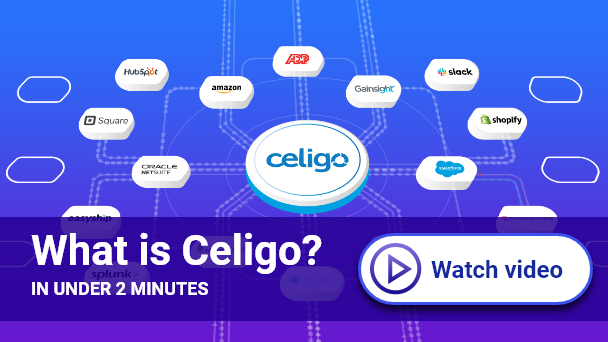
Q
[related-content]
